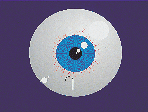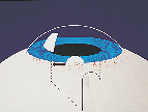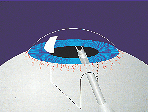J-incision for cataract surgery more secure than conventional frown
A study concludes that a J-shaped incision leaks less, and allows surgeons to use a small incision technique, even with a rigid IOL.
ROSKILDE, Denmark - Small incision cataract surgery is typically reserved for use with foldable IOLs, but according to a study by Jannik Boberg-Ans, MD, of County Hospital here, a J-shaped incision into the limbus enables surgeons to partner small incisions with PMMA lenses. Further, the technique renders cataract incisions more resistant to pressure and leakage than straight or frown incisions.
"The J-incision allows a surgeon to implant a bigger, rigid IOL through a very small incision and yields the same benefits as small incision surgery, producing a tight wound that is astigmatically neutral," Dr. Boberg-Ans said.
Dr. Boberg-Ans's J-incision is a "hip-pocket" wound created at the limbus. It is 2.75-mm long, and features a split in the sclera to one side that allows a 5.5-mm rigid PMMA lens to be implanted with relative ease. Because the intrascleral/corneal tunnel incision is longer than it is wide, the J-incision is tighter and more resistant to pressure than a conventional frown or straight limbal incision.
Making the cut
To create a J-incision, Dr. Boberg-Ans said to first stamp an imprint at the limbus with a 2.75-mm crescent bevel-up steel knife. With a preset diamond knife, cut a 0.25-mm deep incision in the shape of a J with its base starting at the limbus. The crescent bevel knife is then placed back on the J-incision, and the surgeon gently presses forward while rotating in very tiny circles toward the front edge of the incision. The blade should penetrate the incision cleavage, creating a suitable short tunnel for phacoemulsification. Next, the tunnel is widened to 5.5 mm to the top of the J, along its straight side. The internal corneal lip is then created with a steel keratome, and phacoemulsification is performed.
Prior to implantation of the IOL, the internal corneal lip is widened to match the lens diameter. The lens is implanted sideways into the tunnel and then forward into the capsular bag.
Comparison
| J-incision vs. Straight Incision | ||
|---|---|---|
| J-incision (n=18) | Straight incision (n=17) | |
| No leak | 17 (94.5%) | 12 (70.6%) |
| Leak | 0 (0%) | 2 (11.8%) |
| Inconclusive | 1 (5.5%) | 3 (17.6%) |
| P < .075 Source: J. Boberg-Ans, MD | ||
In a study designed to compare the effectiveness of the J-incision with conventional limbal incisions, Dr. Boberg-Ans enrolled 35 patients with an average age of 76 years, and randomized the group to receive either a J-incision during surgery or a conventional straight incision. Eighteen patients received a J-incision and 17 received a straight incision.
At the end of the cataract surgery, Dr. Boberg-Ans measured intraocular pressure (IOP) to verify that it was between 13 and 21 mm Hg prior to administering a pressure test. On average, postop IOP was 17 mm Hg for all patients. Eyes with pressure outside these limits were injected with saline through the side incision until the IOP was within 13 to 21 mm Hg.
A dynamometer, with a footplate of 7.5 mm, was placed on the distal wound lip. Slowly, pressure was increased to 100 g on the dynamometer while the anterior chamber and wound site was visually monitored for leakage through the operating microscope. In the event that leakage occurred, the test was discontinued. In the event of an inconspicuous slight leak, test results were categorized as "inconclusive."
Of the eyes that underwent a J-incision, 17 (94.5%) showed no leakage when pressure was increased to 100 g and only one eye was categorized as inconclusive.
In the straight incision group, 12 of 17 (70.6% of eyes) did not leak. Three eyes were considered inconclusive.
"The numbers are only statistically significant on a P value of .075, and therefore no firm conclusion could be drawn, but J-incision seems more resistant to digital pressure on the wound lips compared with a straight incision," he said. "That we are certain of."
Dr. Boberg-Ans explained that it is important that you make an internal lip cut parallel to the limbus and keep the cleavage level in the tunnel. He said it is an easy incision to master.
"Even surgeons with little surgical experience can learn it quickly," he said.
Dr. Boberg-Ans presented his study at the 1998 meeting of the International Ophthalmology Microsurgery Group.
| Construction and Use of the J-Incision | |
|---|---|
|
|
|
|
|
For your information:
- Jannik Boberg-Ans, MD, is a cataract specialist at County Hospital in Roskilde, Denmark. He can be reached at ++(46) 30-24-75; fax: ++(46) 32-10-55. Dr. Boberg-Ans has no direct financial interest in any of the products mentioned in this article, nor is he a paid consultant for any companies mentioned.




